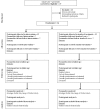Support and Assessment for Fall Emergency Referrals (SAFER 1) trial protocol. Computerised on-scene decision support for emergency ambulance staff to assess and plan care for older people who have fallen: evaluation of costs and benefits using a pragmatic cluster randomised trial
- PMID: 20102616
- PMCID: PMC2824628
- DOI: 10.1186/1471-227X-10-2
Support and Assessment for Fall Emergency Referrals (SAFER 1) trial protocol. Computerised on-scene decision support for emergency ambulance staff to assess and plan care for older people who have fallen: evaluation of costs and benefits using a pragmatic cluster randomised trial
Abstract
Background: Many emergency ambulance calls are for older people who have fallen. As half of them are left at home, a community-based response may often be more appropriate than hospital attendance. The SAFER 1 trial will assess the costs and benefits of a new healthcare technology--hand-held computers with computerised clinical decision support (CCDS) software--to help paramedics decide who needs hospital attendance, and who can be safely left at home with referral to community falls services.
Methods/design: Pragmatic cluster randomised trial with a qualitative component. We shall allocate 72 paramedics ('clusters') at random between receiving the intervention and a control group delivering care as usual, of whom we expect 60 to complete the trial.Patients are eligible if they are aged 65 or older, live in the study area but not in residential care, and are attended by a study paramedic following an emergency call for a fall. Seven to 10 days after the index fall we shall offer patients the opportunity to opt out of further follow up. Continuing participants will receive questionnaires after one and 6 months, and we shall monitor their routine clinical data for 6 months. We shall interview 20 of these patients in depth. We shall conduct focus groups or semi-structured interviews with paramedics and other stakeholders.The primary outcome is the interval to the first subsequent reported fall (or death). We shall analyse this and other measures of outcome, process and cost by 'intention to treat'. We shall analyse qualitative data thematically.
Discussion: Since the SAFER 1 trial received funding in August 2006, implementation has come to terms with ambulance service reorganisation and a new national electronic patient record in England. In response to these hurdles the research team has adapted the research design, including aspects of the intervention, to meet the needs of the ambulance services.In conclusion this complex emergency care trial will provide rigorous evidence on the clinical and cost effectiveness of CCDS for paramedics in the care of older people who have fallen.
Trial registration: ISRCTN10538608.
Figures
Similar articles
-
Support and assessment for fall emergency referrals (SAFER 2) research protocol: cluster randomised trial of the clinical and cost effectiveness of new protocols for emergency ambulance paramedics to assess and refer to appropriate community-based care.BMJ Open. 2012 Nov 12;2(6):e002169. doi: 10.1136/bmjopen-2012-002169. Print 2012. BMJ Open. 2012. PMID: 23148348 Free PMC article.
-
Support and Assessment for Fall Emergency Referrals (SAFER) 2: a cluster randomised trial and systematic review of clinical effectiveness and cost-effectiveness of new protocols for emergency ambulance paramedics to assess older people following a fall with referral to community-based care when appropriate.Health Technol Assess. 2017 Mar;21(13):1-218. doi: 10.3310/hta21130. Health Technol Assess. 2017. PMID: 28397649 Free PMC article. Clinical Trial.
-
Support and Assessment for Fall Emergency Referrals (SAFER 1): cluster randomised trial of computerised clinical decision support for paramedics.PLoS One. 2014 Sep 12;9(9):e106436. doi: 10.1371/journal.pone.0106436. eCollection 2014. PLoS One. 2014. PMID: 25216281 Free PMC article. Clinical Trial.
-
Implementation and use of computerised clinical decision support (CCDS) in emergency pre-hospital care: a qualitative study of paramedic views and experience using Strong Structuration Theory.Implement Sci. 2018 Jul 4;13(1):91. doi: 10.1186/s13012-018-0786-x. Implement Sci. 2018. PMID: 29973225 Free PMC article.
-
The Economic Impact of Community Paramedics Within Emergency Medical Services: A Systematic Review.Appl Health Econ Health Policy. 2024 Sep;22(5):665-684. doi: 10.1007/s40258-024-00902-3. Epub 2024 Jul 17. Appl Health Econ Health Policy. 2024. PMID: 39017994 Free PMC article.
Cited by
-
Multifactorial and multiple component interventions for preventing falls in older people living in the community.Cochrane Database Syst Rev. 2018 Jul 23;7(7):CD012221. doi: 10.1002/14651858.CD012221.pub2. Cochrane Database Syst Rev. 2018. PMID: 30035305 Free PMC article.
-
Evolving prehospital, emergency department, and "inpatient" management models for geriatric emergencies.Clin Geriatr Med. 2013 Feb;29(1):31-47. doi: 10.1016/j.cger.2012.09.003. Clin Geriatr Med. 2013. PMID: 23177599 Free PMC article. Review.
-
Rapid analgesia for prehospital hip disruption (RAPID): protocol for feasibility study of randomised controlled trial.Pilot Feasibility Stud. 2017 Jan 23;3:8. doi: 10.1186/s40814-016-0115-6. eCollection 2017. Pilot Feasibility Stud. 2017. PMID: 28163926 Free PMC article.
-
Referral pathways for patients with TIA avoiding hospital admission: a scoping review.BMJ Open. 2017 Feb 14;7(2):e013443. doi: 10.1136/bmjopen-2016-013443. BMJ Open. 2017. PMID: 28196949 Free PMC article.
-
Support and assessment for fall emergency referrals (SAFER 2) research protocol: cluster randomised trial of the clinical and cost effectiveness of new protocols for emergency ambulance paramedics to assess and refer to appropriate community-based care.BMJ Open. 2012 Nov 12;2(6):e002169. doi: 10.1136/bmjopen-2012-002169. Print 2012. BMJ Open. 2012. PMID: 23148348 Free PMC article.
References
-
- Sikron F, Giveon A, Aharmson-Daniel L, Peleg K. My home is my castle! Or is it? Hospitalizations following home injury in Israel,1997-2001. Israel Medical Association Journal. 2004;6:332–35. - PubMed
-
- Kellogg International Work Group. The prevention of falls in later life. KIWG on the Prevention of Falls by the Elderly. Dan Med Bull. 1987;4:1–24. - PubMed
-
- Tinetti ME. Factors associated with serious injury during falls by ambulatory nursing home residents. J AmGeriatr Soc. 1987;35:644–48. - PubMed
Publication types
MeSH terms
Associated data
LinkOut - more resources
Full Text Sources
Medical
Research Materials
Miscellaneous


